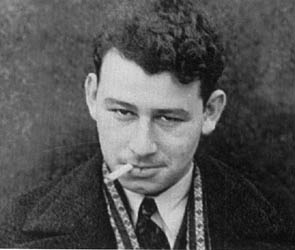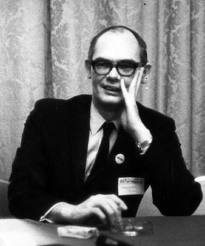************************************************
Introduction
Most science fiction critics and historians would agree, I believe, that the most significant writing team in the field’s history, most productive of enduring, classic works, was the unfortunately brief collaboration between Frederik Pohl and Cyril Kornbluth. Their collaboration had its roots in the friendship they shared during their teen days in the late 1930s (Pohl was born in 1919 and Kornbluth in 1923); it reached its zenith in the 1950s before being cut tragically short by Kornbluth’s death at the age of 34 in 1958. I would venture to say the only SF collaboration which has come close in significance to that between Pohl and Kornbluth was the team of Larry Niven and Jerry Pournelle. Niven’s and Pournelle’s collaborative novels, best sellers all, have sold many multiples the copies sold of Pohl’s and Kornbluth’s four SF novels (although Pohl has pointed out that The Space Merchants has been translated into twenty-five languages, and he estimates that in its various editions, it has sold about ten million copies — so maybe the sales discrepancy between Pohl/Kornbluth and Niven/Pournelle isn’t as big as you’d think). But Pohl’s and Kornbluth’s shared works have had a far greater impact on the field’s development and the writers who followed.
Science fiction has long been rich in collaborations, much more so than most other realms of fiction. I think this is due to the fact that, at least since the 1920s and the commercialization of science fiction as a genre with the founding of Amazing Stories, science fiction writers and fans (many of whom grow up to become writers themselves) have been intensely social with one another (at least relative to writers in other genres). Their earliest efforts to reach out to one another were through the letters columns of the early science fiction magazines. From these remote connections, they formed clubs, and those clubs, beginning in the late 1930s, began sponsoring conventions. A group of fans who called themselves the Futurians even established communal living arrangements in the depths of the Depression. An amazingly high percentage of the Futurians went on to become prominent writers and editors in the science fiction field. Two of the most active Futurians, in terms of writing, editing, and reportage, were Frederik Pohl and Cyril Kornbluth. They were also very close friends.
During the 1950s, beginning with The Space Merchants in 1952 (first published in shorter form as Gravy Planet in Galaxy Science Fiction), they published seven novels together. Four of these were science fiction; The Space Merchants was followed by Search the Sky (1954), Gladiator-at-Law (1955), and Wolfbane (1957 in Galaxy; reprinted in longer form by Ballantine Books in 1959). The first of their novel-length collaborations (they also published numerous short stories together) and the latter two are considered classics; all three have been reprinted multiple times. A collection of their shared short fiction, The Wonder Effect, was published in 1962, four years after Kornbluth’s death.
During their six-year period of intensive collaboration, they both published novels and stories outside of their team, either with other collaborators or singly. Kornbluth published two science fiction novels in collaboration with Judith Merrill, Outpost Mars (1952) and Gunner Cade (1952). He also published three solo science fiction novels, Takeoff (1952), The Syndic (1953), and Not This August (1955). During his lifetime, his short fiction was collected in several volumes, The Explorers (1954), The Mindworm and Other Stories (1955), and A Mile Beyond the Moon (1958). Pohl wrote the Undersea Trilogy with Jack Williamson, another frequent Pohl collaborator; these were Undersea Quest (1954), Undersea Fleet (1956), and Undersea City (1958). He also wrote Preferred Risk (1955) with Lester del Rey (which, according to Pohl’s lengthy recorded conversation with Alfred Bester in June, 1978, was a much less pleasurable and frictionless experience than his collaborations with either Kornbluth or Williamson). Pohl’s solo novels during this decade included Slave Ship (1956) and Drunkard’s Walk (1960), and his story collections included Alternating Currents (1956), The Case Against Tomorrow (1957), Tomorrow Times Seven (1959), and The Man Who Ate the World (1960).
None of the novels Pohl and Kornbluth wrote during the decade of the 1950s, either singly or in collaboration with writers other than each other, achieved anywhere near the acclaim accorded three of their jointly written novels, and none of them are much remembered or read today. Pohl went on to write other novels on his own, starting with Man Plus in 1976 and including Gateway (1977) and Jem (1979), which could be considered the equal of his best collaborations with Cyril Kornbluth. But these were written two decades or more after the books he did with Kornbluth, in a renewed period of novel writing which followed fifteen years of serving as editor for Galaxy Science Fiction, Worlds of If, and Bantam Books.
What made the Pohl-Kornbluth collaboration so magical? What skills and attributes did each bring to the team, attributes which meshed so well and so memorably together? Why were neither of them able to capture that same magic when working separately in the 1950s, at least not in long-form works? (They were more successful as soloists on short pieces; at least half a dozen of Kornbluth’s short stories can be counted among the best short science fiction of the 1950s, and several of Pohl’s short pieces from the decade are very highly regarded, as well.)
Fred Pohl has written frequently about his collaboration with Cyril Kornbluth, in his memoir The Way the Future Was (1978), his introductions to The Best of C. M. Kornbluth (1976), Our Best: The Best of Frederik Pohl and C. M. Kornbluth (1987), and His Share of Glory: The Complete Short Science Fiction of C. M. Kornbluth (1997), and on his very entertaining blog, The Way the Future Blogs. Cyril Kornbluth, unfortunately, did not live long enough to leave us with reminiscences of his working relationship with Fred Pohl (Kornbluth strained his heart carrying a fifty caliber machine gun throughout the Battle of the Bulge and died of a heart attack fourteen years later, after shoveling snow from his driveway and then running to catch a train). In the articles to follow, I will review their joint work and compare it with some of their contemporaneous solo work. Between that effort and taking into consideration some of Pohl’s remarks about their collaboration and Kornbluth’s strengths and weaknesses as a writer, I’ll attempt to separate out the elements that they each brought to their shared works. In this way, I’ll try to illustrate their differing but complementary modes of craftsmanship and explicate the magic of their collaboration.
Next: The Space Merchants







Looking forward to more.
Dean, it’s coming! Look for part 2, which will cover THE SPACE MERCHANTS, either late this evening or sometime tomorrow (Wednesday) morning. Just in the process of finishing that post up…
[…] Introduction […]